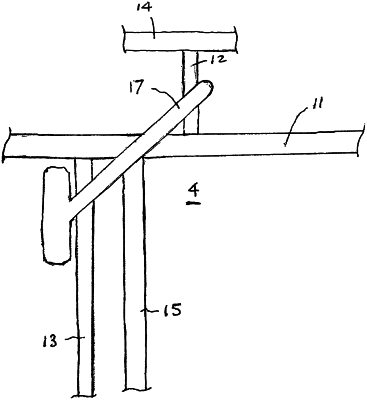| CPC E04B 1/2608 (2013.01) [E04B 2/56 (2013.01); E04F 13/06 (2013.01); E06B 1/62 (2013.01); B60P 3/36 (2013.01); E06B 1/02 (2013.01)] | 18 Claims |

|
1. A device for reinforcing intersecting studs in framing construction, comprising:
(a) a unitary body of sheet metal having a base, a middle section and a terminal section;
(b) wherein the middle and terminal sections are elongated and share a common longitudinal axis, are each about 1 to 2 inches wide and collectively are about 8 to 16 inches long;
(c) wherein the base section is 1 to 2 inches wide and 4 to 6 inches long as measured along a longitudinal axis;
(d) wherein, in a flat condition, the longitudinal axis of the middle and terminal sections are at an angle relative to the longitudinal axis of the base section, the angle being between 30 degree and 60 degrees; and thereafter said base section is bent orthogonal to said middle section along an axis that is parallel to said longitudinal axis of said base section, and said axis of said bend is located at a boundary between said base section and said middle section;
(e) said base section remaining in a flat condition following said base section being bent to permit said base section, during use in construction, to be placed flush against a side of a first construction stud and moved along the side of the stud to a desired position where said middle and terminal sections extend somewhat beyond a second construction stud intersecting the first construction stud;
(f) further wherein said middle section is attached to a long dimension of said base section;
(g) still further wherein the first construction stud and the second intersecting construction stud form at least a portion of a frame;
(h) still further wherein said device is configured such that said terminal section is capable of being bent such that said terminal section is orthogonal with respect to said middle section and lying flush against a surface of (i) the second intersecting construction stud, or (ii) a third construction stud intersecting the second construction stud; and
(i) said device configured to accept fasteners through at least said base and terminal sections for the purpose of securing said device to the first construction stud and to at least one of the second and third construction studs.
|